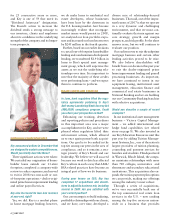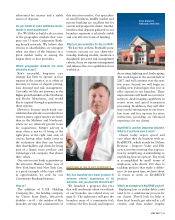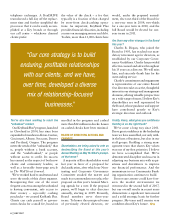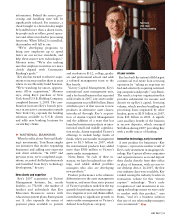KeyBank 2007 Annual Report Download - page 16
Download and view the complete annual report
Please find page 16 of the 2007 KeyBank annual report below. You can navigate through the pages in the report by either clicking on the pages listed below, or by using the keyword search tool below to find specific information within the annual report.14
MANAGEMENT’S DISCUSSION & ANALYSIS OF FINANCIAL CONDITION & RESULTS OF OPERATIONS KEYCORP AND SUBSIDIARIES
INTRODUCTION
This section generally reviews the financial condition and results of
operations of KeyCorp and its subsidiaries for each of the past three
years. Some tables may include additional periods to comply with
disclosure requirements or to illustrate trends in greater depth. When you
read this discussion, you should also refer to the consolidated financial
statements and related notes that appear on pages 61 through 104.
Terminology
This report contains some shortened names and industry-specific terms.
We want to explain some of these terms at the outset so you can better
understand the discussion that follows.
•KeyCorp refers solely to the parent holding company.
•KeyBank refers to KeyCorp’s subsidiary bank, KeyBank National
Association.
•Key refers to the consolidated entity consisting of KeyCorp and its
subsidiaries.
• In November 2006, Key sold the subprime mortgage loan portfolio
held by the Champion Mortgage finance business and announced a
separate agreement to sell Champion’s origination platform. As a result
of these actions, Key has accounted for this business as a discontinued
operation. We use the phrase continuing operations in this document
to mean all of Key’s business other than Champion. Key completed
the sale of Champion’s origination platform in February 2007.
• Key engages in capital markets activities primarily through business
conducted by the National Banking group. These activities encompass
a variety of products and services. Among other things, Key trades
securities as a dealer, enters into derivative contracts (both to
accommodate clients’ financing needs and for proprietary trading
purposes), and conducts transactions in foreign currencies (both to
accommodate clients’ needs and to benefit from fluctuations in
exchange rates).
• All earnings per share data included in this discussion are presented
on a diluted basis, which takes into account all common shares
outstanding as well as potential common shares that could result from
the exercise of outstanding stock options and other stock awards.
Some of the financial information tables also include basic earnings
per share, which takes into account only common shares outstanding.
• For regulatory purposes, capital is divided into two classes. Federal
regulations prescribe that at least one-half of a bank or bank holding
company’s total risk-based capital must qualify as Tier 1. Both total
and Tier 1 capital serve as bases for several measures of capital
adequacy, which is an important indicator of financial stability and
condition. You will find a more detailed explanation of total and Tier
1 capital and how they are calculated in the section entitled “Capital,”
which begins on page 42.
Description of business
KeyCorp is one of the nation’s largest bank-based financial services
companies, with consolidated total assets of $100.0 billion at December
31, 2007. Through KeyBank and certain other subsidiaries, KeyCorp
provides a wide range of retail and commercial banking, commercial
leasing, investment management, consumer finance, and investment
banking products and services to individual, corporate and institutional
clients through two major business groups: Community Banking and
National Banking. As of December 31, 2007, KeyBank operated 955 full
service retail banking branches in thirteen states, a telephone banking
call center services group and 1,443 automated teller machines in
fifteen states. Additional information pertaining to KeyCorp’s two
business groups appears in the “Line of Business Results” section,
which begins on page 23, and in Note 4 (“Line of Business Results”),
which begins on page 75.
In addition to the customary banking services of accepting deposits and
making loans, KeyCorp’s bank and trust company subsidiaries offer
personal and corporate trust services, personal financial services, access
to mutual funds, cash management services, investment banking and
capital markets products, and international banking services. Through
its subsidiary bank, trust company and registered investment adviser
subsidiaries, KeyCorp provides investment management services to
clients that include large corporate and public retirement plans,
foundations and endowments, high net worth individuals and
multiemployer trust funds established to provide pension, vacation or
other benefits to employees.
KeyCorp provides other financial services — both inside and outside of
its primary banking markets — through nonbank subsidiaries. These
services include accident, health and credit-life insurance on loans
made by KeyBank, principal investing, community development
financing, securities underwriting and brokerage, and merchant services.
KeyCorp also is an equity participant in a joint venture that provides
merchant services to businesses.
Forward-looking statements
This report may contain “forward-looking statements” within the
meaning of the Private Securities Litigation Reform Act of 1995,
including statements about Key’s long-term goals, financial condition,
results of operations, earnings, levels of net loan charge-offs and
nonperforming assets, interest rate exposure and profitability. These
statements usually can be identified by the use of forward-looking
language such as “our goal,” “our objective,” “our plan,” “will likely
result,” “expects,” “plans,” “anticipates,” “intends,” “projects,”
“believes,” “estimates,” or other similar words, expressions or
conditional verbs such as “will,” “would,” “could,” and “should.”
Forward-looking statements express management’s current expectations,
forecasts of future events or long-term goals and, by their nature, are
subject to assumptions, risks and uncertainties. Although management
believes that the expectations, forecasts and goals reflected in these
forward-looking statements are reasonable, actual results could differ
materially from the forward-looking statements for a variety of reasons,
including the following factors.
Interest rates. Net interest income can be affected by changes in market
interest rates (higher or lower) and the composition of Key’s interest-
earning assets and interest-bearing liabilities.
























